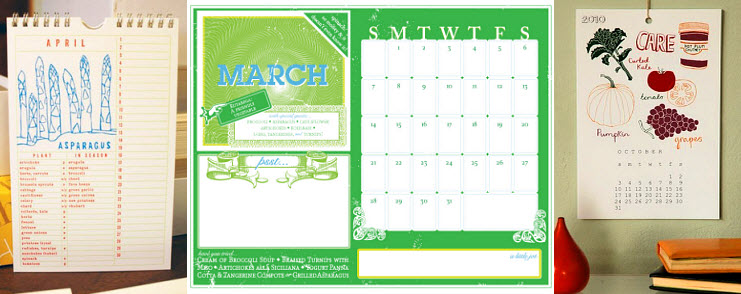How to Be A Locavore: In the Green
People say it’s not easy being green, but we say it’s a heck of a lot harder being an all-out locavore. Who, in this day and age of supermarkets and instant gratification, actually knows when a carrot’s in season? Or where those little buggers come from in the first place?
Well, if you’re like us (and can’t tell your fennel from your celery, let alone whether it’s local or in season), you need some help. First and foremost, scope out your local farmer’s market and snoop around – it’s full of your very own resident experts, so don’t be afraid to quiz them on the subject!
Here are three other easy steps you can take to get your local on.
Step 1: Know Your Seasons
First things first, whether you’re an aspiring gardener or just an ignorant consumer, you need to know what’s local when. One of the best ways to keep in the know and ahead of the curve are these fabulous 2010 calendars that feature seasonal produce every month.
From Left to Right: For you Californians, a handy-dandy notebook calendar from KrankPress on Etsy ($20); A free (!) printable calendar from the Cottage Industrialist; A fabulous 2010 calendar ($24) also available as a poster ($20)Â – and even a tea towel! ($12) – from Claudia G. Pearson on Etsy.
Step 2: Use Technology
As you might have guessed, as there is for seemingly everything these days, there’s an App for being a locavore too. Two of our favorites are the Locavore and GoodGuide iPhone Apps. Locavore, $2.99 on iTunes, lets you know what’s local in your state, pulls up both Wikipedia links and Epicurious recipes, and alerts you to local Farmers’ Markets. GoodGuide scans the barcode of the object you’re picking up at the grocery store and lets you know its health, environmental, and social performance (in other words, how much – or little – the earth and its inhabitants were harmed in the making of this product).
If you’ve yet to jump on the iPhone bandwagon, there’s also some handy Web Sites you can check out, like Epicurious’ interactive Seasonal Ingredient Map and Sustainable Table, which has information on Famers’ Markets and Food Co-ops, Shopping Guides, and more.
Step 3: Cook Smart!
Of course, most Chefs wised up to the local food movement way before the average layperson – so why not take some of their excellent advice (and their excellent recipes too)! There are tons of great options out there, but we’re digging these five.
Clockwise from top left: I am almost always hungry by Lora Zarubin, a cookbook with “30 seasonal menus” and “unique insights into the subtleties of seasonal entertaining.” $20.53 on Amazon.com; Local Flavors: Cooking and Eating from America’s Farmers’ Markets, by Deborah Madison. $17.16 on Amazon.com; Super Natural Cooking: 5 Delicious Ways to Incorporate Whole and Natural Foods into Your Cooking. $12 on Walmart.com; Clean Food: A Seasonal Guide to Eating Close to the Source, $19.80 on Amazon.com; Lucid Food: Cooking for an Eco-Conscious Life, $18 from Barnes & Noble.


